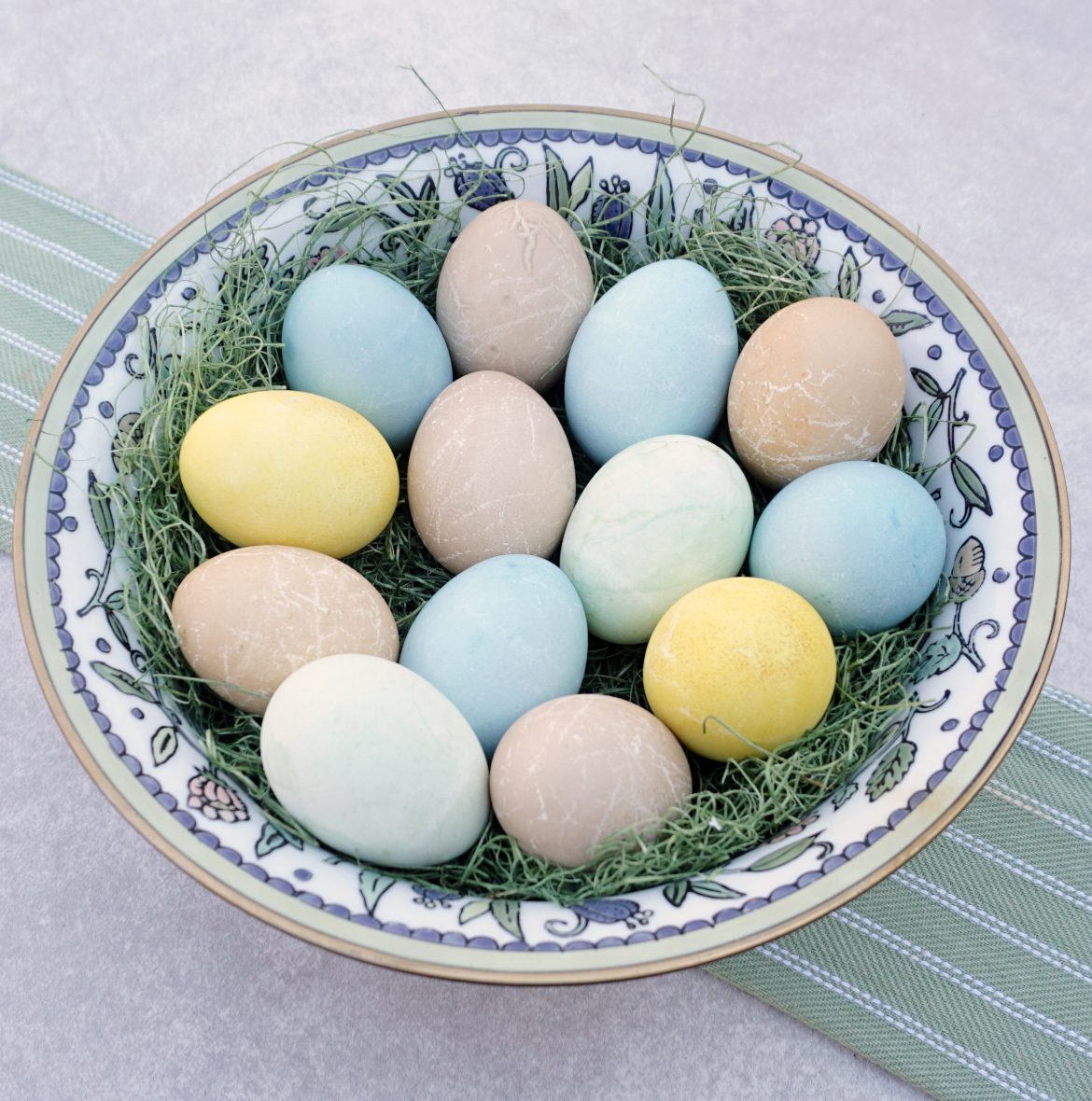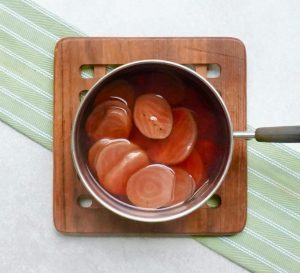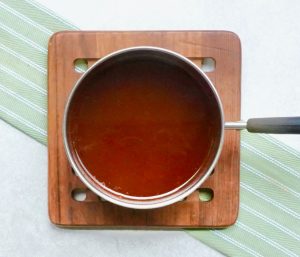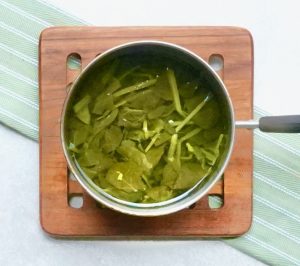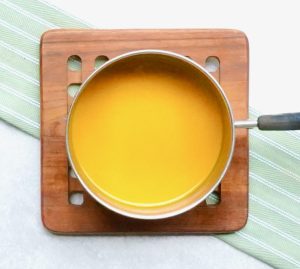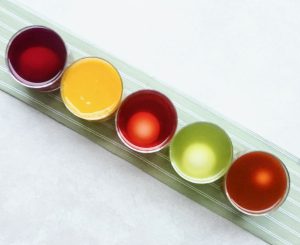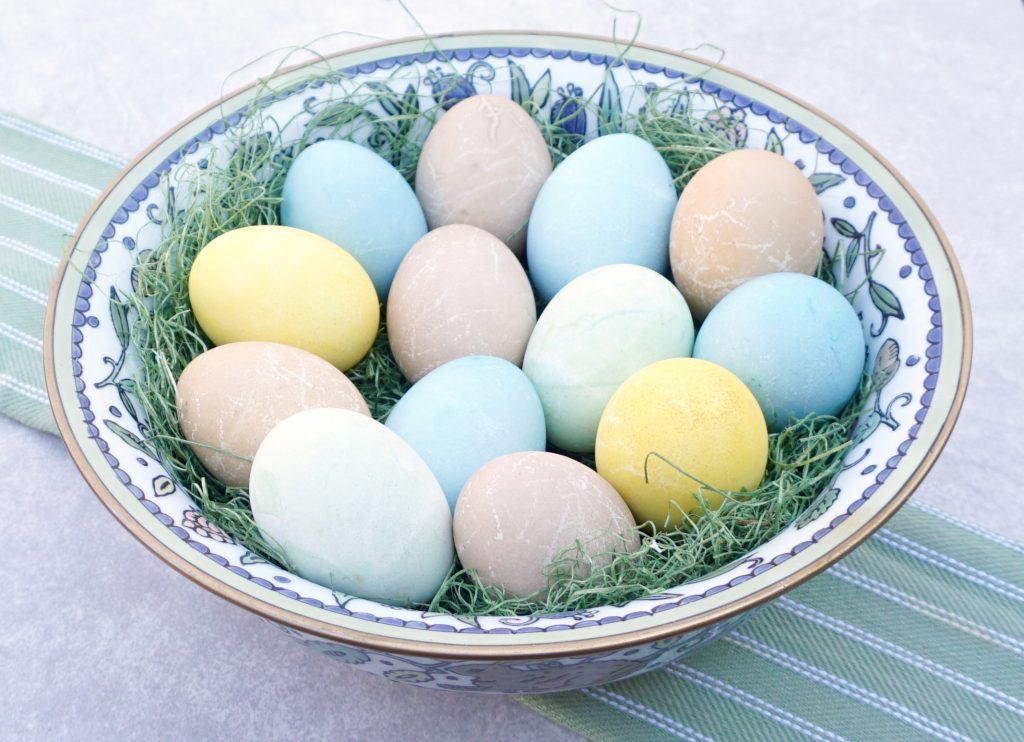Natural Dye Easter Eggs can be made with natural ingredients that you already have in your home. Vegetables and spices are used here as natural dyes to create colorful eggs without any artificial ingredients.
These eggs are not going to have the perfectly vibrant colors that you get when you use artificial colors and chemical dyes. The natural egg dyes will be much paler beautiful colors, and inconsistently colored. That’s what I like about them! Homemade Easter egg dye might just become one of your favorite traditions.
There is no exact timing when you make Natural Dyed Easter Eggs. The turmeric dye will color the eggs really fast. The cabbage, chili and beets will produce nice color in a moderate amount of time. The spinach will produce a really pale green and it will take a very long time. If you are going to skip one, make it the spinach!
To make purple eggs use beets. To make orange eggs use chili powder. To make blue eggs use red cabbage. To make green eggs use spinach. To make yellow eggs use turmeric. These natural plant-based dyes will produce pale shades of color.
You can tuck some colored eggs into the braid of Nisu Bread for Easter dinner. Check out 20 Fun Easter Breakfast Ideas for more ways to celebrate.
If you want a good egg salad recipe to use up the leftovers, check out Pickle Egg Salad.
SOME THINGS TO KNOW:FAQ’S
INGREDIENT TIPS:
- Red cabbage tends to produce more vibrant dyes when simmered longer, so do not hesitate to keep it on the heat until you reach the desired depth of color.
- The longer you let the eggs sit in the beet dye, the deeper the purple color will become.
- Since chili powder is finely ground, make sure you strain the dye well to avoid any gritty texture on the eggs.
- Spinach dye will require a longer soak time for the eggs to achieve a noticeable green hue. Overnight soaking could yield the best results.
- Turmeric stains easily, so handle the dye with care, and use gloves if you want to avoid bright yellow fingers.
- The vinegar is crucial as it helps the dye bond with the eggshell, so do not skip this ingredient. Read The Chemistry of Dyeing Easter Eggs.
SPECIAL EQUIPMENT NEEDED:
- Sauce Pans: You will need several small to medium saucepans, one for each of the various colors of dye you plan to make. This allows you to work on different dyes simultaneously without mixing colors.
- Measuring Cups and Spoons: Accurate measuring cups and spoons are necessary to measure water, vinegar, and dyeing agents (like turmeric, beets, etc.) to create your dyes.
- Fine Mesh Strainer: A fine mesh strainer is needed for removing solid bits from your dye solutions, ensuring a smooth dye that will evenly coat the eggs.
- Mason Jars, Glasses or Disposable Cups: You will need several mason jars glasses or cups to store each color of the food dyes. Glass or ceramic is preferable since these materials won’t absorb the colors like plastic might.
- Slotted Spoon or Egg Dipper: A slotted spoon or a specialized egg dipper is helpful for gently placing the eggs into the dye and removing them without cracking.
- Wire Rack and Paper Towels: After dyeing, you will need a wire rack to dry the eggs. Place paper towels underneath the rack to catch any drips of homemade dye.
- Gloves (Optional): Wearing gloves is optional but recommended to avoid staining your hands, especially when handling dyes like turmeric or beet.
- Apron or Old Clothes: Natural dyes can stain, so wearing an apron or old clothes you don’t mind getting a bit colorful is a good idea.
SUBSTITUTIONS:
- Saffron or yellow onion skins can provide a yellow hue instead of the turmeric. They might need to be boiled longer to extract the full range of color.
- Blackberries or frozen blueberries can also give a purple hue. Crush them and follow the same process as with beets.
- Paprika can work as a substitute for chili powder to achieve an orange dye.
- Purple grape juice (use directly as a dye without boiling) can be an alternative to red cabbage for achieving a bluish tone.
- Matcha powder can yield a green color instead of spinach though the shades may vary.
- If white vinegar is not available, apple cider vinegar can work in the dyeing process. It may slightly alter the color outcome due to its own color.
HOW TO STORE NATURAL DYE EASTER EGGS:
- After dyeing and achieving the desired color, allow the eggs to dry completely on a wire rack. This prevents smudging the colors and ensures the dye has fully set.
- Once dry, the eggs should be placed in an egg carton or a suitable container and stored in the refrigerator.
- Natural Dye Easter eggs are safe to eat within one week of cooking, as long as they have been stored in the refrigerator and not left out for more than two hours total. This includes the time they may have been out during the dyeing process and any time you display them outside the fridge.
Place the raw eggs into a saucepan large enough to hold as many eggs as you want to make. Make sure they are not overcrowded or they will crack. Cover them with water and bring them to a boil. Boil for 10 minutes. Drain and cool the hardboiled eggs.
To make the dyes you need to add 1½ cup water to a saucepan for each color. Then add either the beets, chili powder, cabbage, spinach or turmeric. Bring them to a boil over high heat then reduce the heat to low and simmer for 15 minutes or until you see a vibrant color.
Beets will make a pink/purple dye depending on whether they are raw or cooked.
Chili powder creates an orange dye.
Red Cabbage is used to color the eggs blue.
Spinach makes a pale green dye.
Turmeric will make a pretty yellow color.
Strain each dye into a glass large enough to hold an egg and add 1 tablespoon of vinegar to the glass. Drop one egg into each dye. Stir the eggs to get consistent color and let them sit until they are as desired color you want. The depth of color will depend on how long you leave the eggs in the dye.
Remove the eggs from the dye and place on a baking rack to dry. Repeat the process until all of the eggs are dyed.
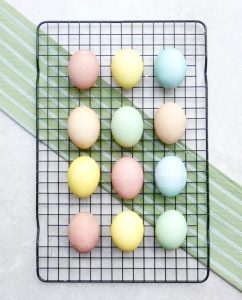
Natural Dye Easter Eggs
Print ThisIngredients
- 1 cup beets, can be cooked or frozen for purple color
- 2 tablespoons chili powder for orange color
- 1 cup shredded purple cabbage for light blue dye
- 2 cups spinach for green hue
- 2 tablespoons turmeric for yellow dye
- hard-boiled eggs, as many as you want at room temperature
- 1 ½ cups water for each color
- 1 tablespoon white vinegar for each color
Instructions
Place the eggs into a saucepan large enough to hold as many eggs as you want to make. Make sure they are not overcrowded or they will crack. Cover them with water and bring them to a boil. Boil for 10 minutes. Drain and cool.
To make the dyes you need to add 1½ cup water to a saucepan for each color. Then add either the beets, chili powder, cabbage, spinach or turmeric. Bring them to a boil over high heat then reduce the heat to low and simmer for 15 minutes or until you see a vibrant color.
Strain each dye into a glass large enough to hold an egg and add 1 tablespoon vinegar to the glass. Drop one egg into each dye.
Stir the eggs to get consistent color and let them sit until they are as deeply colored as you want.
Remove the eggs from the dye and place on a baking rack to dry.
Repeat the process until all of the eggs are dyed.
Have fun making your homemade Easter egg dye! Display the Natural Dye Easter Eggs in a pretty bowl with some Easter grass.

